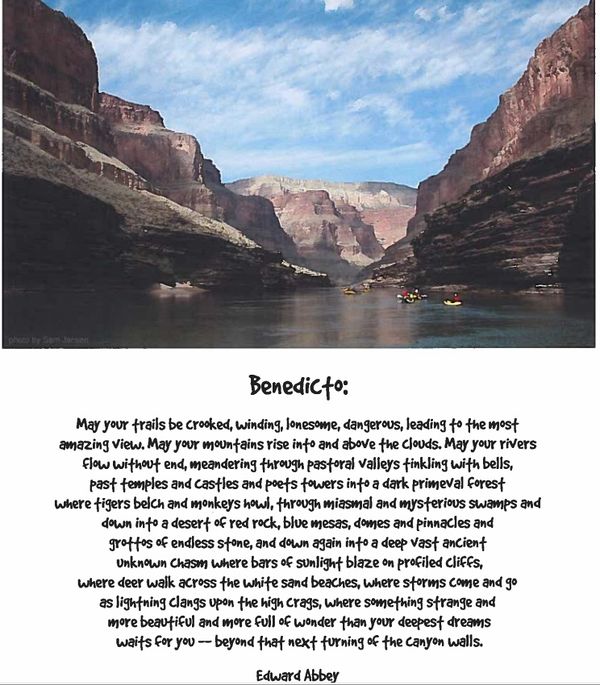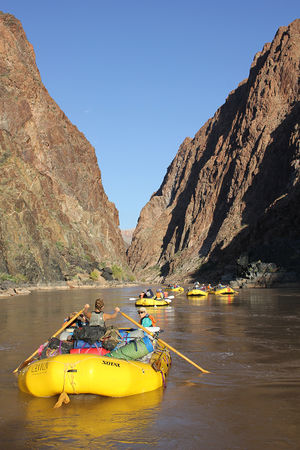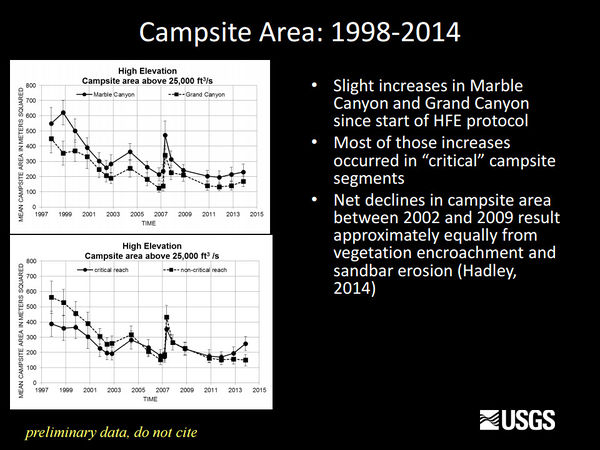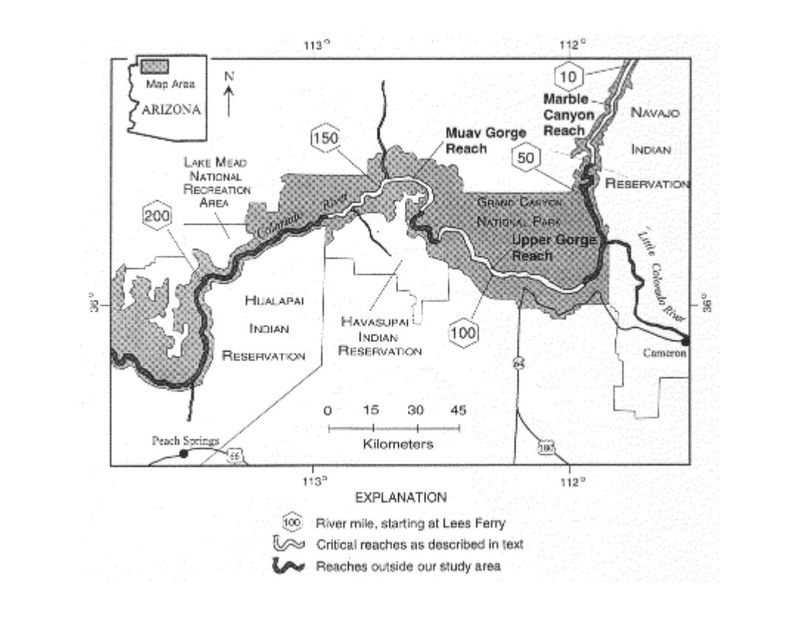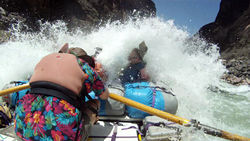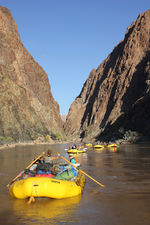- Fact Sheets
- Training
- Knowledge Assessments
- Trivia
- Key Topics
Difference between revisions of "RECREATION"
Cellsworth (Talk | contribs) |
Cellsworth (Talk | contribs) |
||
| (40 intermediate revisions by the same user not shown) | |||
| Line 17: | Line 17: | ||
</table> | </table> | ||
| − | [[File:Benedicto- Poem- Edward Abbey- PIC.jpg|600px]] | + | [[File:Benedicto- Poem- Edward Abbey- PIC.jpg |thumbnail|center|600px]] <br> |
| + | |||
| + | [[File:Granite Gorge- SJansen.JPG|thumbnail|center|300px]] | ||
<!-- | <!-- | ||
| Line 27: | Line 29: | ||
Sandbars have been used as campsites by river runners and hikers since the first expeditions to the region more than 100 years ago. Because the Colorado River is dominated by bedrock cliffs and steep talus slopes, sandbars provide unique areas along the river that are flat, relatively free of vegetation, easily accessible by river runners, and able to withstand high usage with negligible impact. These campsites continue to be an important part of the recreational experience for the more than 25,000 hikers and river runners that visit the Colorado River corridor each year. [https://www.gcmrc.gov/research_areas/sediment_geomorphology/sed/Sed_Geomorph_Camp.aspx] | Sandbars have been used as campsites by river runners and hikers since the first expeditions to the region more than 100 years ago. Because the Colorado River is dominated by bedrock cliffs and steep talus slopes, sandbars provide unique areas along the river that are flat, relatively free of vegetation, easily accessible by river runners, and able to withstand high usage with negligible impact. These campsites continue to be an important part of the recreational experience for the more than 25,000 hikers and river runners that visit the Colorado River corridor each year. [https://www.gcmrc.gov/research_areas/sediment_geomorphology/sed/Sed_Geomorph_Camp.aspx] | ||
| + | |||
| + | The motor season starts on April 1 and lasts through September 15. | ||
==[http://gcdamp.com/index.php?title=Long-term_Experimental_and_Management_Plan_(LTEMP) '''LTEMP Resource Goal for Recreational Experience''']== | ==[http://gcdamp.com/index.php?title=Long-term_Experimental_and_Management_Plan_(LTEMP) '''LTEMP Resource Goal for Recreational Experience''']== | ||
| Line 77: | Line 81: | ||
[[File:CampsiteArea 1998 2014.jpg|center|600px]] | [[File:CampsiteArea 1998 2014.jpg|center|600px]] | ||
| + | |- | ||
| + | ! <h2 style="margin:0; background:#cedff2; font-size:120%; font-weight:bold; border:1px solid #a3b0bf; text-align:left; color:#000; padding:0.2em 0.4em;"> Causal factors for loss of campsite area </h2> | ||
| + | |- | ||
| + | |style="color:#000;"| | ||
| + | |||
| + | There were two primary drivers responsible for the net loss in campsite area — (1) increases and decreases in campsite area as a result of deposition and erosion associated with controlled floods and regular dam operations and (2) long-term declines in campsite area due to vegetation encroachment. Gains and losses in campsite area associated with topographic change can cancel each other out, whereas vegetation change, for the most part, only leads to losses in campsite area. In terms of net change, vegetation encroachment contributed to 47 percent of the overall net loss in campsite area, and topographic change contributed to 53 percent of the overall net loss in campsite area. | ||
| + | |||
| + | Controlled floods can lead to increases in campsite area and are currently the only management strategy used to improve campsites along the Colorado River corridor. However, erosion of flood-deposited sandbars during normal dam operations following controlled floods causes these increases in campsite area to be short lived. At the same time, vegetation cover continues to increase, resulting in the progressive decline of campsite area. | ||
| + | |||
| + | One potential strategy to increase campsite area more often is more frequent implementation of controlled floods to build sandbars. This strategy was initiated by the Bureau of Reclamation in 2012 by the adoption of a high-flow experimental protocol. This protocol allows for the implementation of a controlled flood every year, provided there is sufficient sand supplied by the Paria River (Bureau of Reclamation, 2012). Preliminary findings indicate that the protocol is resulting in larger sandbars (Grams and others, 2015). However, there is not always a direct correlation between increases in sandbar size and increases in campsite area. Whether this strategy leads to increases in campsite area that meet the management objectives set forth by the Glen Canyon Dam Adaptive Management Program for increasing the size of campsite area in critical and noncritical reaches remains uncertain. | ||
| + | |||
| + | Removal of vegetation may be another viable strategy for increasing the size of campsite area. Although most vegetation expansion is occurring in noncritical reaches, these sites tend to be larger in size and more numerous along the river corridor. Physically removing vegetation at these sites would likely accomplish little in terms of increasing recreational carrying capacity, because many of these sites can still accommodate large river groups despite having increases in vegetation cover. Instead, targeting smaller sites in critical reaches and focusing on removal of groundcover shrubs such as arrowweed and camelthorn (and (or) removal of tamarisk that is impacted by tamarisk beetle herbivory) would likely be the most practical and successful vegetation removal strategy. [https://doi.org/10.3133/sir20175096] | ||
|- | |- | ||
| − | ! <h2 style="margin:0; background:#cedff2; font-size:120%; font-weight:bold; border:1px solid #a3b0bf; text-align:left; color:#000; padding:0.2em 0.4em;"> Critical Reaches </h2> | + | ! <h2 style="margin:0; background:#cedff2; font-size:120%; font-weight:bold; border:1px solid #a3b0bf; text-align:left; color:#000; padding:0.2em 0.4em;"> Critical Reaches </h2> |
|- | |- | ||
|style="color:#000;"| | |style="color:#000;"| | ||
| Line 85: | Line 101: | ||
*Marble Canyon (river miles 9-41) | *Marble Canyon (river miles 9-41) | ||
*Upper Gorge (river miles 71-114) | *Upper Gorge (river miles 71-114) | ||
| − | *Muav Gorge (river miles 131-165) | + | *Muav Gorge (river miles 131-165) |
| − | [[File:CriticalReaches.jpg|center|800px]] | + | [[File:CriticalReaches.jpg|thumb|center|800px| [https://www.gcmrc.gov/library/reports/cultural/Recreation/01WRGR0007/AAB%202000.pdf Changes to Grand Canyon Camping Beaches, Year 2000: Annual Report of Repeat Photography by Grand Canyon River Guides, Inc. (Adopt-a-Beach Program)] ]] |
| + | |||
| + | |- | ||
| + | ! <h2 style="margin:0; background:#cedff2; font-size:120%; font-weight:bold; border:1px solid #a3b0bf; text-align:left; color:#000; padding:0.2em 0.4em;"> What makes a beach campable? </h2> | ||
| + | |- | ||
| + | |style="color:#000;"| | ||
| + | |||
| + | *The threshold of 8 degrees is used to describe the approximate threshold for areas considered flat enough to use for camping (Kearsley and others, 1994; Hadley and others, 2018). | ||
|} | |} | ||
| Line 94: | Line 117: | ||
|class="MainPageBG" style="width:45%; border:1px solid #cedff2; background:#f5faff; vertical-align:top;"| | |class="MainPageBG" style="width:45%; border:1px solid #cedff2; background:#f5faff; vertical-align:top;"| | ||
{| width="100%" cellpadding="2" cellspacing="5" style="vertical-align:top; background:#f5faff;" | {| width="100%" cellpadding="2" cellspacing="5" style="vertical-align:top; background:#f5faff;" | ||
| − | ! <h2 style="margin:0; background:#cedff2; font-size:120%; font-weight:bold; border:1px solid #a3b0bf; text-align:left; color:#000; padding:0.2em 0.4em;">Information</h2> | + | ! <h2 style="margin:0; background:#cedff2; font-size:120%; font-weight:bold; border:1px solid #a3b0bf; text-align:left; color:#000; padding:0.2em 0.4em;">Information and Links</h2> |
|- | |- | ||
|style="color:#000;"| | |style="color:#000;"| | ||
| − | *[ | + | *[http://gcdamp.com/index.php?title=Portal:GCDAMP_Knowlege_Assessments GCMRC Annual Reports page] |
| − | *[https://www. | + | *[https://www.nps.gov/grca/learn/management/upload/CRMPIF_s.pdf 2006 Colorado River Management Plan] |
| − | *[http://www.gcrg.org/index.php Grand Canyon River Guides] | + | *[http://gcpba.org/ Grand Canyon Private Boaters Association (GCPBA) Page] |
| + | *[http://www.gcrg.org/index.php Grand Canyon River Guides (GCRG) Page ] | ||
*[http://www.gcrg.org/bqr.php Boatman's Quarterly Review] | *[http://www.gcrg.org/bqr.php Boatman's Quarterly Review] | ||
| + | *[https://www.gcmrc.gov/gis/silveratlas1.aspx GCMRC Campsite Atlas] (requires microsoft silverlight plug-in) | ||
| + | *[https://www.gcmrc.gov/gis/camptour/index.html GCMRC Campsite photo tour] | ||
| + | *[http://gcdamp.com/index.php?title=GCDAMP_Sediment Sediment Page] | ||
| + | *[http://gcdamp.com/index.php?title=Riparian_Vegetation Vegetation Page] | ||
*[http://gcdamp.com/index.php?title=FISHERY The Lees Ferry Rainbow Trout Fishery Page] | *[http://gcdamp.com/index.php?title=FISHERY The Lees Ferry Rainbow Trout Fishery Page] | ||
| − | *[http://gcdamp.com/index.php?title= | + | *[http://gcdamp.com/index.php?title=GCDAMP-_Over-Flights Over Flights Page] |
|- | |- | ||
| Line 133: | Line 161: | ||
|- | |- | ||
|style="color:#000;"| | |style="color:#000;"| | ||
| + | |||
| + | '''2024''' | ||
| + | *[[Media:DebrisFlowRisk_ARM_Poster_reviewed2.pdf | Debris flow risk at campsites in Grand Canyon]] | ||
| + | |||
| + | '''2023''' | ||
| + | *[https://www.usbr.gov/uc/progact/amp/twg/2023-01-26-twg-meeting/20230126-AnnualReportingMeeting-Assessing50yearsEcologicalChangesCampsitesColoradoRiverGrandCanyon-508-UCRO.pdf Assessing 50 years of ecological changes at campsites along the Colorado River in Grand Canyon] | ||
| + | |||
| + | '''2022''' | ||
| + | *[https://www.usbr.gov/uc/progact/amp/twg/2022-06-16-twg-meeting/20220616-AdoptABeach-508-UCRO.pdf Adopt-A-Beach ] | ||
| + | |||
| + | '''2021''' | ||
| + | *[https://www.usbr.gov/uc/progact/amp/amwg/2021-02-11-amwg-meeting/20210211-LifeNeedsRivers-Presentation-508-UCRO.pdf Life Needs Rivers ] | ||
| + | *[https://www.usbr.gov/uc/progact/amp/twg/2021-01-22-twg-meeting/20210122-AnnualReportingMeeting-ModelingToolsManagementRecreationGlenGrandCanyons-508-UCRO.pdf Modeling Tools for Management: Recreation in Glen and Grand Canyons ] | ||
| + | |||
| + | '''2020''' | ||
| + | *[https://www.usbr.gov/uc/progact/amp/twg/2020-06-24-twg-meeting/20200624-AdoptABeachPhotography.pdf The Adopt-A-Beach Repeat Photography Project ] | ||
| + | *[https://gcc02.safelinks.protection.outlook.com/?url=https%3A%2F%2Fwww.usgs.gov%2Fmission-areas%2Fecosystems%2Fscience%2Fusgs-ecosystems-podcast-series-outstanding-field%3Fqt-science_center_objects%3D0%23qt-science_center_objects&data=04%7C01%7C%7C0480a242627b46269d6308d87f5b43b8%7C31ae220fb94f463a9cfd15bbc9909df5%7C0%7C0%7C637399377259505498%7CUnknown%7CTWFpbGZsb3d8eyJWIjoiMC4wLjAwMDAiLCJQIjoiV2luMzIiLCJBTiI6Ik1haWwiLCJXVCI6Mn0%3D%7C1000&sdata=znP5xAcqaMCf9FPdLCvKxLdftJvFwhnagMPpf2%2BG2nQ%3D&reserved=0 Sandbars and vegetation in Grand Canyon—podcast] | ||
| + | *[https://www.usbr.gov/uc/progact/amp/twg/2020-01-13-twg-meeting/20200113-AnnualReportingMeeting-ChangesSandbarsCampsitesDuringHFEProtocol-Presentation-508-UCRO.pdf Changes in sandbars and campsites during the HFE Protocol ] | ||
| + | |||
| + | '''2018''' | ||
| + | *[https://www.usbr.gov/uc/progact/amp/twg/2018-10-10-twg-meeting/Attach_08.pdf Before and After Monsoon Beach/Camp Photos PPT] | ||
| + | *[https://doi.org/10.1002/rra.3349 Hadley et al., 2018, Quantifying geomorphic and vegetation change at sandbar campsites in response to flow regulation and controlled floods, Grand Canyon National Park, Arizona: River Research and Applications] | ||
| + | *[https://doi.org/10.3133/sir20175096 Hadley et al., 2018, Geomorphology and vegetation change at Colorado River campsites, Marble and Grand Canyons, Arizona: U.S. Geological Survey Report ] [https://doi.org/10.5066/F7FJ2FQQ data] | ||
| + | *[https://doi.org/10.1080/09640568.2018.1435411 Neher et al., 2018, Exploring convergent validity between willingness to pay elicitation methods—An application to Grand Canyon whitewater boaters: Journal of Environmental Planning and Management] | ||
| + | |||
| + | '''2017''' | ||
| + | *[http://dx.doi.org/10.1002/2017WR020729 Neher et al., 2017, Testing the limits of temporal stability—Willingness to pay values among Grand Canyon whitewater boaters across decades. Water Resource Research] | ||
'''2016''' | '''2016''' | ||
| Line 147: | Line 202: | ||
'''2013''' | '''2013''' | ||
*[http://www.gcrg.org/bqr.php Lauck. 2013. To Re-photograph or Not, That is the Question: The Adopt-A-Beach Program Marches On: Boatman’s Quaterly Review, Winter 2013-2014, 26, 4, p. 21-23.] | *[http://www.gcrg.org/bqr.php Lauck. 2013. To Re-photograph or Not, That is the Question: The Adopt-A-Beach Program Marches On: Boatman’s Quaterly Review, Winter 2013-2014, 26, 4, p. 21-23.] | ||
| + | |||
| + | '''2012''' | ||
| + | *[https://www.gcmrc.gov/about/ka/KA%202%20-%202-1-12/AM%20Talks/Fairley%200930-1015%20Camp%20Sites.pdf Camp Sites] | ||
'''2010''' | '''2010''' | ||
*[http://pubs.usgs.gov/sir/2010/5015/ Hazel et al. 2010. Sandbar response in Marble and Grand Canyons, Arizona, following the 2008 high-flow experiment on the Colorado River: U.S. Geological Survey Scientific Investigations Report 2010-5015, 52 p.] | *[http://pubs.usgs.gov/sir/2010/5015/ Hazel et al. 2010. Sandbar response in Marble and Grand Canyons, Arizona, following the 2008 high-flow experiment on the Colorado River: U.S. Geological Survey Scientific Investigations Report 2010-5015, 52 p.] | ||
*[http://pubs.usgs.gov/sir/2010/5135/ Kaplinskiet al. 2010. Colorado River campsite monitoring, 1998–2006, Grand Canyon National Park, Arizona, in Melis et al. eds., Proceedings of the Colorado River Basin Science and Resource Management Symposium, November 18-20, 2008, Scottsdale, Arizona: U.S. Geological Survey Scientific Investigations Report 2010-5135, 275-284 p.] | *[http://pubs.usgs.gov/sir/2010/5135/ Kaplinskiet al. 2010. Colorado River campsite monitoring, 1998–2006, Grand Canyon National Park, Arizona, in Melis et al. eds., Proceedings of the Colorado River Basin Science and Resource Management Symposium, November 18-20, 2008, Scottsdale, Arizona: U.S. Geological Survey Scientific Investigations Report 2010-5135, 275-284 p.] | ||
| + | |||
| + | '''1999''' | ||
| + | *[https://www.usbr.gov/uc/progact/amp/twg/1999-10-22-twg-meeting/Attach_12.pdf Behan, J. 1999, Recreation in the Colorado River Ecosystem, Grand Canyon, white paper to GCMRC] | ||
| + | |||
| + | |- | ||
| + | ! <h2 style="margin:0; background:#cedff2; font-size:120%; font-weight:bold; border:1px solid #a3b0bf; text-align:left; color:#000; padding:0.2em 0.4em;">[http://gcdamp.com/index.php?title=Bishop_Study Bishop Study and River Recreation Preferences]</h2> | ||
| + | |- | ||
| + | |style="color:#000;"| | ||
| + | |||
| + | In Bishop et al. (1987; on page 410 of the 30 page report: “Grand Canyon Recreation and Glen Canyon Dam Operations: An Economic Evaluation) fluctuating flows are defined as any operation where the daily flow fluctuation was equal to or more than 10,000 cfs/day. Bishop treated daily flow fluctuations of less than 10,000 cfs/day as “constant flow releases.” Bishop identified that this “10,000 cfs threshold was determined to be the point at which fluctuations begin to be perceptible to recreationists.” <br> | ||
| + | |||
| + | Additionally, Stewart et al.’s (2000) follow-up of the Bishop et al. (1987) study found that angler’s did not identify river level fluctuations, at least under the MLFF operating regime, as an issue. Based on information from Stewart et al (2000) and Bishop et al. (1987), '''any flow fluctuation below 10,000 cfs/day should be treated the same as a steady flow release'''. | ||
| + | |||
| + | *[http://www.gcmrc.gov/library/reports/cultural/Recreation/Stewart2000.pdf The Stewart Report: Preferences of Recreation User Groups of the Colorado River in Grand Canyon. 2000] | ||
| + | *[http://www.swrcb.ca.gov/water_issues/programs/ocean/cwa316/docs/cwa316may2010/comments041310/bishop_etal.pdf The Bishop Study: Grand Canyon Recreation and Glen Canyon Dam Operations: An Economic Evaluation. 1987. pg 407-436 ] | ||
| + | *[[File:1987 Bishop GCDam releases downstream rec analysis user pref.pdf| The Bishop Study: Glen Canyon Dam Releases and Down Stream Recreation: An Analysis of User Preferences and Economic Values. 1987. Report to GCES. 398 pgs. ]] | ||
|- | |- | ||
| Line 157: | Line 231: | ||
|style="color:#000;"| | |style="color:#000;"| | ||
| − | *<SPAN>[[Rafting Folder| '''RAFTING''']] | + | *<SPAN>[[Rafting Folder| '''RAFTING''']] | [[Hiking Folder|'''HIKING''']] | [[GCDAMP--Fishing Folder|'''FISHING''']] |[[Camping Folder|'''CAMPING''']] | [[Boating Folder | '''BOATING''']] | [[Kayaking Folder| '''KAYAKING''']] | [[Overflights Folder| '''OVERFLIGHTS]]</Span> |
---- | ---- | ||
<Span>[[File:Itll blow your hat off- SJansen.jpg |250px]][[File:Granite Gorge- SJansen.JPG|150px]][[File:Kayaking the CR-PIC.jpg|150px]]</Span> | <Span>[[File:Itll blow your hat off- SJansen.jpg |250px]][[File:Granite Gorge- SJansen.JPG|150px]][[File:Kayaking the CR-PIC.jpg|150px]]</Span> | ||
| + | *[https://www.youtube.com/watch?v=x7eESAr895g Grand Canyon Rafting - Documentary of Major Rapids (Horn Creek, Lava, Crystal)] | ||
*[http://www.ksl.com/?sid=41565135&nid=1288&title=a-look-at-4-early-pioneers-of-utah-river-running A look at 4 early pioneers of Utah river running] | *[http://www.ksl.com/?sid=41565135&nid=1288&title=a-look-at-4-early-pioneers-of-utah-river-running A look at 4 early pioneers of Utah river running] | ||
*[http://www.greencarreports.com/news/1101910_now-you-can-ride-an-all-electric-raft-down-the-colorado-river|Now You Can Ride An All-Electric Raft Down The Colorado River] | *[http://www.greencarreports.com/news/1101910_now-you-can-ride-an-all-electric-raft-down-the-colorado-river|Now You Can Ride An All-Electric Raft Down The Colorado River] | ||
Latest revision as of 16:21, 5 February 2024
|
|
Colorado River RecreationSandbars have been used as campsites by river runners and hikers since the first expeditions to the region more than 100 years ago. Because the Colorado River is dominated by bedrock cliffs and steep talus slopes, sandbars provide unique areas along the river that are flat, relatively free of vegetation, easily accessible by river runners, and able to withstand high usage with negligible impact. These campsites continue to be an important part of the recreational experience for the more than 25,000 hikers and river runners that visit the Colorado River corridor each year. [1] The motor season starts on April 1 and lasts through September 15. LTEMP Resource Goal for Recreational ExperienceMaintain and improve the quality of recreational experiences for the users of the Colorado River Ecosystem. Recreation includes, but is not limited to, flatwater and whitewater boating, river corridor camping, and angling in Glen Canyon. Desired Future Condition for for RecreationRiver Recreation in Grand Canyon National Park The Recreation DFCs are meant to describe goals and objectives for human use of the Colorado River Ecosystem (CRE) through GCNRA and the GCNP. They are intended to include not only traditional recreational activities such as whitewater rafting, camping, and fishing, but also such things as educational activities, spiritual engagement, and other appropriate activities and values. Grand Canyon and Glen Canyon offer many ways for people to experience, appreciate, and learn from them, even to those who never visit in person. |
| --- |
--- |
--- |
|---|
|
|
